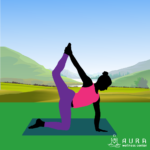You’re Not Me – Avoiding Students Comparisons to Instructors
Have you noticed students making comparisons to instructors in yoga practice – in less obvious signs (such as glances and facial expressions) or more directly (such as clear verbal statements)? Do you wonder how best to balance modeling mindful, strong and anatomically informed practice and avoiding the creation of these student comparisons?
Like many balances we strive to strike as instructors, it’s not always an easy one to find. But, with mindfulness and discretion, it’s not impossible. In a prior article, I discussed strategies for minimizing our students comparing themselves to their fellow students. After a class one day from a favorite instructor of mine, my mental focus shifted to how students can make comparisons to instructors.
For the most part, yoga instructors have strong asana practices. They also most often exhibit the calm energy through the physical challenges of asana, aided by deep and sustained flow of breath, that is at the heart of true yoga practice. Students can see all of that and devalue their own abilities through comparison, push harder and faster than their bodies are ready for, or decide to leave the practice completely.
During that class, my instructor discussed how the aesthetics of a pose are largely meaningless. “That’s why I don’t demo a lot”, he explained, “because my poses aren’t your poses”. This led me to think more deeply about unintended effects of certain teaching approaches such as demonstrating postures and sequences. With that, here are some guidelines for reducing such effects, students comparing themselves to us in particular, while keeping our teaching toolboxes necessarily stocked to the brim.
Demonstrate Mindfully and Thoroughly
My instructor has a valuable point, by implication of his above statement, about how demonstrating as instructors can result in students comparing themselves to us as instructors. That’s most often not a good thing, for stated and other such reasons. Further, it runs counter to a central philosophical tenet of yoga – that each person’s practice is unique and valuable in its own way, so long as it is moving towards best serving that person in how they are at any given point – in body, mind, and spirit.
Demonstrating has key benefits, and is sometimes indispensable – such as when teaching beginning students and they need a primary visual representation of a posture or transition. How do we gain those benefits and avoid the downsides? Firstly, demonstrate two to three “leveled” variations of certain postures. That conveys how various different ways of executing a certain posture – and not only the most “advanced” one, one that you as the instructor might be able to execute without breaking a sweat – are equally valid and beneficial.
Next, be sure to clearly and assertively tell students that this is what the given posture “looks” like on you. It will look different on each of them. That’s a wonderful thing about asana practice! At best, they’ll take the message to heart and thenceforth put it into practice. If not, if they’re skeptical, you might still plant seeds of this truth that will grow when the practitioner is ready.
You’re Human, and You’ve Had to Practice, Too!
Students don’t always stay aware that we instructors have had very human setbacks, failings, efforts, and achievements. The fact that we’re the leaders in the yoga class context, in a largely conformist society, can account for much of this effect. Some students can see teachers as paragons of yoga knowledge and ability, ones whose level they could never reach or surpass. The result could be undervaluing their abilities, or even leaving the practice entirely from strong discouragement. We can counter those suppositions by showing our students that we have had our own journeys of practices, ones that will continue. Everyone, including famous yogis and instructors gracing covers of Yoga Journal, has room to grow. Short of drawn-out explanations such as that, which can sometimes stall the momentum of our classes (especially faster-moving ones such as those in Vinyasa style), we can share brief stories about challenges we have faced in practice.
We can describe how – with our own receptive attitudes and perseverance, as well as support from instructors and fellow yogis – we overcame those challenges. If certain postures don’t come very naturally to us, we can share that with a touch of humor. If we fall out of balances or other standing postures while demonstrating, we can laugh at ourselves good-naturedly and try again – minus extraneous drama. But try again with mindfulness and any useful knowledge we might have gained on the last attempt.
Students might just follow those positive examples, and from that grow into richer, more beneficial practices. Actions can truly speak louder than words. Again, even if they’re not fully receptive to the message at a given time, our examples might just plant seeds that will blossom when students have created the conditions for that growth within themselves. So, comparisons to instructors will happen. Shanti and gratitude to you, dear readers, in your leading your students towards that.
© Copyright – Aura Wellness Center – Publications Division
See our testimonials to find out what our graduates have to say about our selection of online yoga teacher certification courses.
Please feel free to share our posts with your friends, colleagues, and favorite social media networks.


Interesting read. I am studying on the mind/ body and scientific use of yoga and pain management.